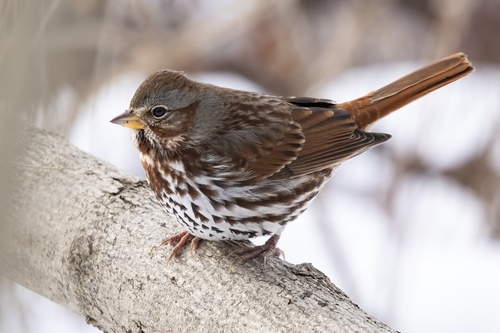
Fox Sparrow
The Fox Sparrow (*Passerella iliaca*) is a large, striking sparrow of North America, known for its rich, rusty coloration and vigorous ground-foraging behavior. It plays a vital ecological role as a seed disperser and insect consumer within its various habitats, which range from dense forests to shrubby thickets. While not widely recognized in popular culture, it holds a special place among birdwatchers for its beautiful song and the subtle variations in appearance across its different subspecies.
15-19 cm
Length
26-30 cm
Wingspan
Least Concern
Conservation Status
Distribution
Breeds across North America, from Alaska and northern Canada south through the western mountains to California, and in the east to Newfoundland and the northeastern United States. Winters in the southern United States and Mexico.
Lifespan
Typically 3-5 years in the wild, but up to 10 years recorded.
Fox Sparrow's Habitat
Habitat Types
Boreal forests, Coniferous forests, Mixed woodlands, Shrublands, Thickets, Riparian areas
Climate Zones
Boreal, Temperate, Subarctic
Adaptations
Prefers dense undergrowth for cover and foraging. Strong legs and feet are adapted for scratching through leaf litter.
Variations
There are four main subspecies groups: the "Red" Fox Sparrow (eastern North America and interior west), the "Sooty" Fox Sparrow (Pacific Northwest coast), the "Slate-colored" Fox Sparrow (interior western North America), and the "Thick-billed" Fox Sparrow (California). These groups differ significantly in plumage color and bill size.
Appearance
Breeding Plumage
Plumage is generally similar year-round, though breeding birds may have slightly brighter colors.
Seasonal Feather Changes
Minimal seasonal variation.
Sex Based Plumage Differences
Males and females have similar plumage.
Notable Features
Bold, reddish-brown streaking on the breast and flanks (in the 'Red' group)., Gray or brown upperparts, depending on the subspecies., Strong, conical bill., Dark eye., White or lightly streaked belly.
Diet and Feeding
Primary Foods
Seeds, Insects, Berries, Other small invertebrates
Foraging Behavior
Forages primarily on the ground, using a distinctive "double-scratch" technique, kicking both feet backwards simultaneously to uncover food in leaf litter and soil.
Specializations
Strong legs and feet are well-suited for ground foraging.
Seasonal Diet Variations
Diet shifts seasonally, with more insects consumed during the breeding season and more seeds and berries in the winter.
Behavior
Social Structure
Generally solitary or in pairs during the breeding season. May form small flocks during migration and winter.
Communication
A loud, clear, musical song, often described as a series of whistles and trills., Various call notes, including a sharp "chink".
Migration
Migratory, with northern populations moving south for the winter. Migration routes and timing vary depending on the subspecies and breeding location.
Territorial or Group Behaviors
Males defend breeding territories through song and aggressive displays. Outside of the breeding season, they are less territorial.
Conservation
Threats
Habitat loss and degradation (due to logging, development, and agriculture)., Climate change (potential shifts in breeding range and habitat suitability)., Collisions with buildings and other structures during migration.
Protection Programs
General bird conservation efforts, such as habitat preservation and restoration., Monitoring programs to track population trends.
Local National Laws
Protected under the Migratory Bird Treaty Act in the United States and similar legislation in Canada.
Population Trend
Stable
Population Estimates
Global population estimated at 42,000,000.
Interesting Facts
Fox Sparrows are known for their vigorous foraging style.
Their "double-scratch" technique is unique among sparrows and helps them uncover food in dense leaf litter.
The four subspecies groups are quite distinct.
Some ornithologists believe they may represent separate species.
The "Sooty" Fox Sparrow, is one of the darkest subspecies.
Its dark plumage is thought to be an adaptation to the humid, dark forests of the Pacific Northwest.
Faqs about Fox Sparrow
What is the best way to attract Fox Sparrows to my yard?
Provide dense, shrubby cover and allow leaf litter to accumulate. Offer bird feeders with mixed seeds, especially during the winter.
How can I tell a Fox Sparrow from other sparrows?
Look for its large size, rusty or dark brown coloration (depending on the subspecies), and heavily streaked breast. Observe its distinctive ground-foraging behavior.
Do Fox Sparrows mate for life?
Fox Sparrows are typically monogamous during a single breeding season, but they may choose new partners in subsequent years. More research is needed to determine the extent of pair bond fidelity.
Copyright @ Nature Style Limited. All Rights Reserved.
 English
English